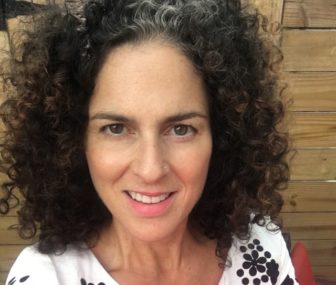
ESB Professional/Shutterstock
.
I am known to borrow tips, tricks and tools from all kinds of sources. I rely on a multitude of frameworks from the field of youth development to support or further the work I do.
You may be familiar with the Search Institute’s 40 Developmental Assets Framework or their Developmental Relationships Framework? Maybe you’re familiar with or use CASEL’s social and emotional framework to design appropriate activities or to train staff?
I also integrate tools and strategies from other fields such as this managing complex change framework for when I am working with organizations of all sizes that are working toward change. I’ve used World Café and Appreciative Inquiry to foster and facilitate conversations.

Rebecca Fabiano
One such framework I am eager to begin using with our organization is called Human-centered Design. This framework aligns closely with the strengths-based approach underlying a positive youth development framework.
I’ve been thinking about how we can use a human-centered design (HCD) approach to improve our recruitment and retention in our youth programs, so I sat down in Philadelphia with Rachel Aucott, director of social impact, and Keighan Gunther, manager of strategy, Youth & Gateway Programs, both at JEVS Human Services, to talk about how they are integrating human-centered design work into their youth programs.
Since 1941, JEVS has helped participants improve their employability, independence and quality of life through skills training, job readiness and career services, vocational rehabilitation, recovery services, adult residential and community participation services, and in-home personal assistance. One of the largest nonprofits in the Delaware Valley, JEVS serves nearly 30,000 individuals each year through more than 30 distinct programs, including individuals with physical, developmental and behavioral challenges; opportunity youth; justice system-involved youth and adults; returning citizens; the un- and under-employed; and anyone who’s looking for support on their path.
This is a synopsis of our conversation and its main points.
What got JEVS interested in HCD?
JEVS was initially interested in HCD as a catalyst for innovation. At JEVS, we work to stay current in our fields of work and to develop state-of-the-art, high-impact services for the individuals we serve, and the promise of adopting HCD — which has been used so effectively outside the nonprofit sector — to help us generate more and better ideas was appealing. If tech companies could use HCD to breathe new life into their work and advance their for-profit mission, why couldn’t we use it to advance our social mission?
More importantly, HCD is aligned with our organizational philosophy to design services with our participants’ lived experience in mind. We know that the best way to build better programs is to listen to participants and approach challenges and opportunities with a spirit of curiosity and empathy, and we were excited to explore new tools to help us advance this approach.
The first time it was used
Our first experiment with HCD was in our 11-person executive management team’s annual goal planning meeting. We wanted to find a more engaging way to develop a strategic action plan for the agency together, so we tried using some HCD-style planning activities.
At first, the response was hesitant: People resisted the more hands-on, visual and open-ended style, wondering if these activities were “serious” enough for such an important conversation. But then, there were some flashes of insight and surprise when new ideas came forward and priorities snapped into focus. We didn’t necessarily resolve our fatigue or dramatically invigorate our strategic planning process, but we left the meeting feeling a subtle shift in tone.
Our first experience using HCD methods with program participants was in an in-school youth program that was closing out due to a shift in funding. We brought together a group of youth participants and program staff to think through how to best use our remaining funds to support young people as they finished out the program: What were their top priorities, and what support could we offer that would be most valuable?
Despite our best intentions, the session did not go very well. Our youth participants weren’t familiar with this style of conversation (they were used to the teacher-to-student model rather than the 360-feedback-and engagement model) and were a little confused by the activities, causing disengagement. From this experience, we learned that we needed to adapt our HCD tools for the youth context: Choose the right environment, set ground rules for the conversation, keep it simple, offer very clear examples of how activities work and explain what will be done with youth feedback/ideas.
Considerations
What should other youth-serving organizations consider if they want to apply it?
- Human-centered design is a mindset, not a prescriptive model of activities or a set of tools. It’s a way of thinking about your work and your participants that shifts the focus from just meeting regulations, pleasing funders, etc. back to the people you’re serving and their strengths, needs and goals.
- Be ready to change your mind! Those of us who choose to work in the nonprofit sphere do so because we care about the people and communities we serve, and we have our participants’ best interests at heart. When we take the time to solicit participant input, we might be surprised by what we hear. If we’re going to ask for feedback, we should be prepared to take it!
- Cultural change takes time; using HCD tools may help facilitate change faster than you might expect. One surprising outcome of JEVS’ experience with HCD is that some of the most immediate impact has been the small shifts we’ve seen in organizational culture. Exploring HCD can help organizations reset cultural expectations around trust, hierarchy, transparency and the process of decision-making.
- Identify an executive-level champion for your organization’s HCD efforts. Buy-in from the leadership team is critical to getting any complex change off the ground, particularly one that adjusts the cultural norms and practices of your organization.
- Consider investing in some training for your organization. Investing in staff professional development in human-centered design was extremely valuable for us — having many staff engaged in the HCD process has helped the new mindset “stick,” and the HCD “practice champions” we’ve developed among staff have been a valuable resource.
- Think about your physical spaces. Are your program spaces open, welcoming, and conducive to collaboration?
Rebecca Fabiano, master of science in education, is the founder and president of Fab Youth Philly, a values-driven organization that supports youth-serving organizations, connects youth development professionals to networking and professional development and innovates original programming for children and teens.






























